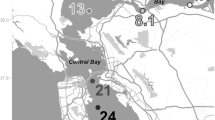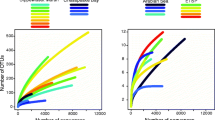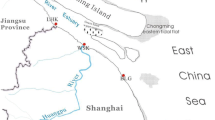Abstract
Denitrification, which results in the loss of bioavailable nitrogen—an essential macronutrient for all living organisms—may potentially affect chemosynthetic primary production in hydrothermal vent ecosystems where sub-oxic conditions favorable to denitrification are common. Here we describe the diversity and abundance of denitrifying bacteria in the subsurface biosphere at Axial Volcano and the Endeavour Segment on the Juan de Fuca Ridge using a combination of quantitative polymerase chain reaction assays, and small subunit ribosomal RNA (SSU or 16S rRNA) pyrotag and nitrite reductase (nirS) clone library sequencing methods. Bacterial communities were diverse and dominated by members of the ε- and γ-proteobacteria, including taxonomic groups containing known denitrifiers. Assemblages of denitrifiers that could be evaluated by nirS gene sequence comparisons showed low diversity. The single nirS sequence shared by the two locations, affiliated with a γ-proteobacteria isolated from estuarine sediments (Pseudomonas sp. BA2), represented more than half of all sequences recovered when clustered at 97 % identity. All other nirS sequences clustered into different taxonomic groups, indicating important differences in denitrifier community membership between the two sites. Total nirS gene abundance was at least two orders of magnitude lower than 16S rRNA abundance. Overall, our results demonstrate that the diversity and abundance of the nirS gene-containing bacterial community are rather low, as might be expected under the extreme conditions encountered in the subsurface biosphere of hydrothermal vent systems, and do not correlate clearly with any environmental variables investigated (i.e., pH, temperature, and H2S, NO3 −, NH4 + concentrations).




Similar content being viewed by others
References
Alain K, Zbinden M, Le Bris N, Lesongeur F, Quérellou J, Gaill F, Cambon‐Bonavita MA (2004) Early steps in microbial colonization processes at deep‐sea hydrothermal vents. Environ Microbiol 6:227–241
Anderson RE, Brazelton WJ, Baross JA (2011) Using CRISPRs as a metagenomic tool to identify microbial hosts of a diffuse flow hydrothermal vent viral assemblage. FEMS Microbiol Ecol 77:120–133
Anderson RE, Beltrán MT, Hallam SJ, Baross JA (2012) Microbial community structure across fluid gradients in the Juan de Fuca Ridge hydrothermal system. FEMS Microbiol Ecol 83:324–339
Ashelford KE, Chuzhanova NA, Fry JC, Jones AJ, Weightman AJ (2006) New screening software shows that most recent large 16S rRNA gene clone libraries contain chimeras. Appl Environ Microbiol 72:5734–5741
Bourbonnais A, Lehmann MF, Butterfield DA, Juniper SK (2012a) Subseafloor nitrogen transformations in diffuse hydrothermal vent fluids of the Juan de Fuca Ridge evidenced by the isotopic composition of nitrate and ammonium. Geochem Geophys Geosyst 13:Q02T01. doi:10.1029/2011GC003863
Bourbonnais A, Juniper SK, Butterfield DA, Devol AH, Kuypers MMM, Lavik G, Hallam SJ, Wenk CB, Chang BX, Murdock SA, Lehmann MF (2012b) Activity and abundance of denitrifying bacteria in the subsurface biosphere of diffuse hydrothermal vents of the Juan de Fuca Ridge. Biogeosciences 9:4661–4678
Braker G, Fesefeldt A, Witzel KP (1998) Development of PCR primer systems for amplification of nitrite reductase genes (nirK and nirS) to detect denitrifying bacteria in environmental samples. Appl Environ Microbiol 64:3769–3775
Braker G, Zhou J, Wu L, Devol AH, Tiedje JM (2000) Nitrite reductase genes (nirK and nirS) as functional markers to investigate diversity of denitrifying bacteria in Pacific Northwest marine sediment communities. Appl Environ Microbiol 66:2096–2104
Braker G, Ayala-del-Rio HL, Devol AH, Fesefeldt A, Tiedje JM (2001) Community structure of denitrifiers, Bacteria, and Archaea along redox gradients in Pacific Northwest marine sediments by terminal restriction fragment length polymorphism analysis of amplified nitrite reductase (nirS) and 16S rRNA genes. Appl Environ Microbiol 67:1893–1901
Braker G, Schwarz J, Conrad R (2010) Influence of temperature on the composition and activity of denitrifying soil communities. FEMS Microbiol Ecol 73:134–148
Braman RS, Hendrix SA (1989) Nanogram nitrite and nitrate determination in environmental and biological materials by vanadium (III) reduction with chemiluminescence detection. Anal Chem 61:2715–2718
Butterfield DA, Roe KK, Lilley MD, Huber JA, Baross JA, Embley RW, Massoth GJ (2004) Mixing, reaction and microbial activity in the sub-seafloor revealed by temporal and spatial variation in diffuse flow vents at Axial Volcano. In: Wilcock WSD, DeLong EF, Kelley DS, Baross JA, Cary SC (eds) The Subseafloor Biosphere at Mid-Ocean Ridge, Geophysical Monograph Series, vol 144. American Geophysical Union, Washington, pp 269–289
Castro‐González M, Braker G, Farías L, Ulloa O (2005) Communities of nirS‐type denitrifiers in the water column of the oxygen minimum zone in the eastern South Pacific. Environ Microbiol 7:1298–1306
Chadwick WW Jr, Nooner SL, Butterfield DA, Lilley MD (2012) Seafloor deformation and forecasts of the April 2011 eruption at Axial Seamount. Nat Geosci 5:474–477
Chao A, Chazdon RL, Colwell RK, Shen TJ (2005) A new statistical approach for assessing similarity of species composition with incidence and abundance data. Ecol Lett 8:148–159
Chen C, Ho KL, Liu FC, Ho M, Wang A, Ren N, Lee DJ (2013) Autotrophic and heterotrophic denitrification by a newly isolated strain Pseudomonas sp. C27. Bioresour Technol 145:351–356
Chon K, Chang JS, Lee E, Lee JW, Ryu JY, Cho J (2009) Abundance of denitrifying genes coding for nitrate (narG), nitrite (nirS), and nitrous oxide (nosZ) reductases in estuarine versus waste production water effluent fed constructed wetlands. Ecol Eng 1500:1–6
Cline JD (1969) Spectrophotometric determination of hydrogen sulfide in natural waters. Limnol Oceanogr 14:454–458
Dong LF, Smith CJ, Papaspyrou S, Stott A, Osborn AM, Nedwell DB (2009) Changes in benthic denitrification, nitrate ammonification, and anammox process rates and nitrate and nitrite reductase gene abundances along an estuarine nutrient gradient (the Colne Estuary, United Kingdom). Appl Environ Microbiol 75:3171–3179
Edgar RC, Haas BJ, Clemente JC, Quince C, Knight R (2011) UCHIME improves sensitivity and speed of chimera detection. Bioinformatics 27:2194–2200
Falk S, Hannig M, Gliesche C, Wardenga R, Köster M, Jürgens K, Braker G (2007) nirS-containing denitrifier communities in the water column and sediment of the Baltic Sea. Biogeosciences 4:255–268
Gonzalez JM, Portillo MC, Belda-Ferre P, Mira A (2012) Amplification by PCR artificially reduces the proportion of the rare biosphere in microbial communities. PloS One 7:e29973. doi:10.1371/journal.pone.0029973
Guindon S, Dufayard JF, Lefort V, Anisimova M, Hordijk W, Gascuel O (2010) New algorithms and methods to estimate maximum-likelihood phylogenies: assessing the performance of PhyML 3.0. Syst Biol 59:307–321
Hamady M, Lozupone C, Knight R (2009) Fast UniFrac: facilitating high-throughput phylogenetic analyses of microbial communities including analysis of pyrosequencing and PhyloChip data. ISME J 4:17–27
Henry S, Baudoin E, López-Gutiérrez JC, Martin-Laurent F, Brauman A, Philippot L (2004) Quantification of denitrifying bacteria in soils by nirK gene targeted real-time PCR. J Microbiol Methods 59:327–335
Heylen K, Vanparys B, Wittebolle L, Verstraete W, Boon N, De Vos P (2006) Cultivation of denitrifying bacteria: optimization of isolation conditions and diversity study. Appl Environ Microbiol 72:2637–2643
Huber JA, Butterfield DA, Baross JA (2002) Temporal changes in archaeal diversity and chemistry in a mid-ocean ridge subseafloor habitat. Appl Environ Microbiol 68:1585–1594
Huber JA, Butterfield DA, Baross JA (2003) Bacterial diversity in a subseafloor habitat following a deep-sea volcanic eruption. FEMS Microbiol Ecol 43:393–409
Huber T, Faulkner G, Hugenholtz P (2004) Bellerophon: a program to detect chimeric sequences in multiple sequence alignments. Bioinformatics 20:2317–2319
Huber JA, Mark Welch DB, Morrison HG, Huse SM, Neal PR, Butterfield DA, Sogin ML (2007) Microbial population structures in the deep marine biosphere. Science 318:97–100
Huber JA, Cantin HV, Huse SM, Mark Welch DB, Sogin ML, Butterfield DA (2010) Isolated communities of Epsilonproteobacteria in hydrothermal vent fluids of the Mariana Arc seamounts. FEMS Microbiol Ecol 73:538–549
Huse SM, Welch DM, Morrison HG, Sogin ML (2010) Ironing out the wrinkles in the rare biosphere through improved OTU clustering. Environ Microbiol 12:1889–1898
Inagaki F, Takai K, Kobayashi H, Nealson KH, Horikoshi K (2003) Sulfurimonas autotrophica gen. nov., sp. nov., a novel sulfur-oxidizing ε-proteobacterium isolated from hydrothermal sediments in the Mid-Okinawa Trough. Int J Syst Evol Microbiol 53:1801–1805
Inagaki F, Takai K, Nealson KH, Horikoshi K (2004) Sulfurovum lithotrophicum gen. nov., sp. nov., a novel sulfur-oxidizing chemolithoautotroph within the ε-Proteobacteria isolated from Okinawa Trough hydrothermal sediments. Int J Syst Evol Microbiol 54:1477–1482
Jannasch HW, Mottl MJ (1985) Geomicrobiology of deep-sea hydrothermal vents. Science 229:717–725
Jayakumar DA, Francis CA, Naqvi SWA, Ward BB (2004) Diversity of nitrite reductase genes (nirS) in the denitrifying water column of the coastal Arabian Sea. Aquat Microb Ecol 34:69–78
Jayakumar A, O’Mullan G, Naqvi SWA, Ward B (2009) Denitrifying bacterial community composition changes associated with stages of denitrification in oxygen minimum zones. Microbial Ecol 58:350–362
Kaye JZ, Márquez MC, Ventosa A, Baross JA (2004) sp. nov., Halomonas sulfidaeris sp. nov., Halomonas axialensis sp. nov. and Halomonas hydrothermalis sp. nov.: halophilic bacteria isolated from deep-sea hydrothermal-vent environments. Int J Syst Evol Microbiol 54:499–511
Lee RW, Childress JJ (1994) Assimilation of inorganic nitrogen by marine invertebrates and their chemoautotrophic and methanotrophic symbionts. Appl Environ Microbiol 60:1852–1858
Lilley MD, Butterfield DA, Olson EJ, Lupton JE, Macko SA, McDuff RE (1993) Anomalous CH4 and NH4 + concentrations at an unsedimented mid-ocean-ridge hydrothermal system. Nature 364:45–47
Liu X, Tiquia SM, Holguin G, Wu L, Nold SC, Devol AH, Luo K, Palumbo AV, Tiedje JM, Zhou J (2003) Molecular diversity of denitrifying genes in continental margin sediments within the oxygen-deficient zone off the Pacific coast of Mexico. Appl Environ Microbiol 69:3549–3560
López‐García P, Duperron S, Philippot P, Foriel J, Susini J, Moreira D (2003) Bacterial diversity in hydrothermal sediment and epsilonproteobacterial dominance in experimental microcolonizers at the Mid‐Atlantic Ridge. Environ Microbiol 5:961–976
Lozupone C, Knight R (2005) UniFrac: a new phylogenetic method for comparing microbial communities. Appl Environ Microbiol 71:8228–8235
Marchesi JR, Sato T, Weightman AJ, Martin TA, Fry JC, Hiom SJ, Wade WG (1998) Design and evaluation of useful bacterium-specific PCR primers that amplify genes coding for bacterial 16S rRNA. Appl Environ Microbiol 64:795–799
Martin AP (2002) Phylogenetic approaches for describing and comparing the diversity of microbial communities. Appl Environ Microbiol 68:3673–3682
McCollom TM, Shock EL (1997) Geochemical constraints on chemolithoautotrophic metabolism by microorganisms in seafloor hydrothermal systems. Geochim Cosmochim Acta 61:4375–4391
Mehta MP, Baross JA (2006) Nitrogen fixation at 92 °C by a hydrothermal vent archaeon. Science 314:1783–1786
Mulder C, Bazeley‐White E, Dimitrakopoulos P, Hector A, Scherer‐Lorenzen M, Schmid B (2004) Species evenness and productivity in experimental plant communities. Oikos 107:50–63
Mulholland MR, Lomas MW (2008) N uptake and assimilation. In: Capone DG, Bronk DA, Mulholland MR, Carpenter EJ (eds) Nitrogen in the marine environment. Elsevier/Academic, 384, pp 303–384
Nakagawa S, Takai K, Inagaki F, Hirayama H, Nunoura T, Horikoshi K, Sako Y (2005a) Distribution, phylogenetic diversity and physiological characteristics of epsilon‐Proteobacteria in a deep‐sea hydrothermal field. Environ Microbiol 7:1619–1632
Nakagawa S, Inagaki F, Takai K, Horikoshi K, Sako Y (2005b) Thioreductor micantisoli gen. nov., sp. nov., a novel mesophilic, sulfur-reducing chemolithoautotroph within the ε-Proteobacteria isolated from hydrothermal sediments in the Mid-Okinawa Trough. Int J Syst Evol Microbiol 55:599–605
Nakagawa S, Takai K, Inagaki F, Horikoshi K, Sako Y (2005c) Nitratiruptor tergarcus gen. nov., sp. nov. and Nitratifractor salsuginis gen. nov., sp. nov., nitrate-reducing chemolithoautotrophs of the ε-Proteobacteria isolated from a deep-sea hydrothermal system in the Mid-Okinawa Trough. Int J Syst Evol Microbiol 55:925–933
Nogales B, Timmis KN, Nedwell DB, Osborn AM (2002) Detection and diversity of expressed denitrification genes in estuarine sediments after reverse transcription-PCR amplification from mRNA. Appl Environ Microbiol 68:5017–5025
Oakley BB, Francis CA, Roberts KJ, Fuchsman CA, Srinivasan S, Staley JT (2007) Analysis of nitrite reductase (nirK and nirS) genes and cultivation reveal depauperate community of denitrifying bacteria in the Black Sea suboxic zone. Environ Microbiol 9:118–130
Opatkiewicz AD, Butterfield DA, Baross JA (2009) Individual hydrothermal vents at Axial Seamount harbor distinct subseafloor microbial communities. FEMS Microbiol Ecol 70:413–424
Price MN, Dehal PS, Arkin AP (2010) FastTree 2–approximately maximum-likelihood trees for large alignments. PLoS One 5:e9490. doi:10.1371/journal.pone.0009490
Priemé A, Braker G, Tiedje JM (2002) Diversity of nitrite reductase (nirK and nirS) gene fragments in forested upland and wetland soils. Appl Environ Microbiol 68:1893–1900
Ravenschlag K, Sahm K, Pernthaler J, Amann R (1999) High bacterial diversity in permanently cold marine sediments. Appl Environ Microbiol 65:3982–3989
Saleh-Lakha S, Shannon KE, Henderson SL, Goyer C, Trevors JT, Zebarth BJ, Burton DL (2009) Effect of pH and temperature on denitrification gene expression and activity in Pseudomonas mandelii. Appl Environ Microbiol 75:3903–3911
Santoro AE, Boehm AB, Francis CA (2006) Denitrifier community composition along a nitrate and salinity gradient in a coastal aquifer. Appl Environ Microbiol 72:2102–2109
Schloss PD, Westcott SL, Ryabin T, Hall JR, Hartmann M, Hollister EB, Lesniewski RA, Oakley BB, Parks DH, Robinson CJ (2009) Introducing mothur: open-source, platform-independent, community-supported software for describing and comparing microbial communities. Appl Environ Microbiol 75:7537–75541
Schrenk MO, Huber JA, Edwards KJ (2010) Microbial provinces in the subseafloor. Annu Rev Mar Sci 2:279–304
Shao MF, Zhang T, Fang HHP (2010) Sulfur-driven autotrophic denitrification: diversity, biochemistry, and engineering applications. Appl Microbiol Biotechnol 88:1027–1042
Sievert SM, Wieringa E, Wirsen CO, Taylor CD (2007) Growth and mechanism of filamentous‐sulfur formation by Candidatus Arcobacter sulfidicus in opposing oxygen‐sulfide gradients. Environ Microbiol 9:271–276
Smith W, Solow AR, Preston PE (1996) An estimator of species overlap using a modified beta-binomial model. Biometrics 52:1472–1477
Smith CJ, Nedwell DB, Dong LF, Osborn AM (2007) Diversity and abundance of nitrate reductase genes (narG and napA), nitrite reductase genes (nirS and nrfA), and their transcripts in estuarine sediments. Appl Environ Microbiol 73:3612–3622
Solorzano L (1969) Determination of ammonia in natural waters by the phenolhypochlorite method. Limnol Oceanogr 14:799–801
Takai K, Nealson KH, Horikoshi K (2004) Hydrogenimonas thermophila gen. nov., sp. nov., a novel thermophilic, hydrogen-oxidizing chemolithoautotroph within the ε-Proteobacteria, isolated from a black smoker in a Central Indian Ridge hydrothermal field. Int J Syst Evol Microbiol 54:25–32
Takai K, Suzuki M, Nakagawa S, Miyazaki M, Suzuki Y, Inagaki F, Horikoshi K (2006) Sulfurimonas paralvinellae sp. nov., a novel mesophilic, hydrogen-and sulfur-oxidizing chemolithoautotroph within the Epsilon proteobacteria isolated from a deep-sea hydrothermal vent polychaete nest, reclassification of Thiomicrospira denitrificans as Sulfurimonas denitrificans comb. nov. and emended description of the genus Sulfurimonas. Int J Syst Evol Microbiol 56:1725–1733
Tamegai H, Li L, Masui N, Kato C (1997) A denitrifying bacterium from the deep sea at 11,000-m depth. Extremophiles 1:207–211
Thompson JD, Higgins DG, Gibson TJ (1994) CLUSTAL W: improving the sensitivity of progressive multiple sequence alignment through sequence weighting, position-specific gap penalties and weight matrix choice. Nucleic Acids Res 22:4673–4680
Turner S, Pryer KM, Miao VPW, Palmer JD (1999) Investigating deep phylogenetic relationships among cyanobacteria and plastids by small subunit rRNA sequence analysis. J Eukaryot Microbiol 46:327–338
Wang F, Zhou H, Meng J, Peng X, Jiang L, Sun P, Zhang C, Van Nostrand JD, Deng Y, He Z (2009) GeoChip-based analysis of metabolic diversity of microbial communities at the Juan de Fuca Ridge hydrothermal vent. Proc Natl Acad Sci USA 106:4840–4845
Xie W, Wang F, Guo L, Chen Z, Sievert SM, Meng J, Huang G, Li Y, Yan Q, Wu S (2010) Comparative metagenomics of microbial communities inhabiting deep-sea hydrothermal vent chimneys with contrasting chemistries. ISME J 5:414–426
Yue JC, Clayton MK (2005) A similarity measure based on species proportions. Commun Stat Theory 34:2123–2131
Zaikova E, Walsh DA, Stilwell CP, Mohn WW, Tortell PD, Hallam SJ (2010) Microbial community dynamics in a seasonally anoxic fjord: Saanich Inlet, British Columbia. Environ Microbiol 12:172–191
Acknowledgments
The authors wish to thank James Holden, Bill Chadwick, the officer and crew of the R/V Atlantis and R/V Thomas G. Thompson and the Jason and Alvin submersible teams. We specially thank Steven J. Hallam for sharing laboratory space and commenting on a previous version of the manuscript. Kevin Roe analyzed fluids for pH, H2S, dissolved silica, and ammonia on board. Hoang-My Christensen analyzed fluids for Mg and other cations and anions in 2009. We thank Elena Zaikova for laboratory assistance and Dr. Juergen Ehlting and Alyse Hawley for sharing laboratory material and space. The Couchsurfing community is thanked for providing accommodation to A.B.. during laboratory analysis at the University of British Columbia (Vancouver). This work was funded through an NSERC (Natural Sciences and Engineering Research Council of Canada) graduate fellowship and a Rix Family fellowship to A.B.., and by an NSERC Discovery grant and British Columbia Leadership Chair to S.K.J. The research cruises were funded by the US National Oceanic and Atmospheric Administration, Pacific Marine Environmental Laboratory and by the National Science Foundation.
Author information
Authors and Affiliations
Corresponding author
Electronic supplementary material
Below is the link to the electronic supplementary material.
ESM 1
(DOC 263 kb)
Rights and permissions
About this article
Cite this article
Bourbonnais, A., Juniper, S.K., Butterfield, D.A. et al. Diversity and abundance of Bacteria and nirS-encoding denitrifiers associated with the Juan de Fuca Ridge hydrothermal system. Ann Microbiol 64, 1691–1705 (2014). https://doi.org/10.1007/s13213-014-0813-3
Received:
Accepted:
Published:
Issue Date:
DOI: https://doi.org/10.1007/s13213-014-0813-3




